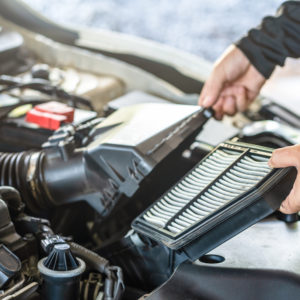One day, as you’re changing your car’s air filter, you notice that there’s oil in the air intake and the air filter housing. You start to worry and wonder whether there’s something seriously wrong with your vehicle.
The bad news is that oil in the air intake and/or air filter housing almost always indicates there’s a problem with your car. Sometimes, the fix is relatively inexpensive and straightforward. In other instances, the engine may require extensive repairs to address the concern.

Four Common Causes of Oil In the Air Intake and/or Air Filter Housing
If your car has oil in the air intake and/or air filter housing, you’ll want to figure out what’s causing the problem right away. Some of the most common causes for the concern include the following:

Blocked or Plugged PCV System
In many cases, oil in the air filter housing and/or air intake has something to do (either directly or indirectly) with the positive crankcase ventilation (PCV) system.
The PCV system vents crankcase vapors—blow-by gases that sneak past the piston rings—from the crankcase to prevent excessive pressure and moisture build-up. Most PCV systems do this by using a valve (though some use a calibrated orifice instead) to regulate airflow through the crankcase.
When the PCV valve opens, fresh air enters the crankcase through a breather hose, which is attached to the air intake. That fresh air is then pulled through the crankcase, creating a scavenging effect that draws blow-by vapors through the PCV valve and into the intake manifold. From there, the vapors enter the engine where they’re burned as part of the normal combustion process.
When the PCV system becomes obstructed, the oily blow-by vapors begin to build-up and eventually get pushed back into the air intake and/or air filter housing. In many cases, the PCV valve or calibrated orifice is the root cause of the problem.
Piston Ring and Cylinder Wall Wear
The PCV system is designed to vent the blow-by vapors that sneak past the piston rings. But when the blow-by becomes excessive—due to worn piston rings or damaged cylinder walls—the PCV system gets overwhelmed. Consequently, the oily blow-by vapors build-up to the point that they get forced into the air intake and/or air filter housing.

Sludge Build-Up
Infrequent service can cause engine oil to turn into a gelatinous goo, called sludge. Eventually, that sludge can clog the engine oil passages that are part of the PCV system, resulting in excessive blow-by and an oily residue in the air intake and/or air filter housing.
Turbocharger/Supercharger Issues
When you’re dealing with a turbocharged or supercharged engine, a small amount of oil in the air intake is usually considered normal. But an excessive accumulation of oil indicates a problem, such as faulty turbocharger/supercharger seals or an obstructed turbocharger return line.
Don’t Overlook Uncommon Causes
When it comes to potential causes of oil in the air intake, the list above is not all-inclusive. Cars can be tricky, and the source of the issue often varies from vehicle to vehicle.
For example, on certain Fords with 3.5L and 3.7L V6 engines, oil can enter the air filter housing due to a poor valve cover design. The fix is to replace the original valve cover with an updated version.
Also, if you significantly overfill your car’s crankcase with oil—to the point that it’s several quarts overfull—excess oil can get pushed back up through the PCV system and into the air intake.
Because there are so many possibilities, you (or your mechanic) should always perform a thorough diagnosis to pinpoint the exact cause of the concern.

Products Mentioned in this Guide
Any information provided on this Website is for informational purposes only and is not intended to replace consultation with a professional mechanic. The accuracy and timeliness of the information may change from the time of publication.


 Air Filter
Air Filter
 PCV Valve
PCV Valve
 Piston Ring Set
Piston Ring Set
 Turbocharger
Turbocharger


























thank you for this article, it really helped determine the best course of action to take towards my vehicle repair. it was informative and easy to follow.